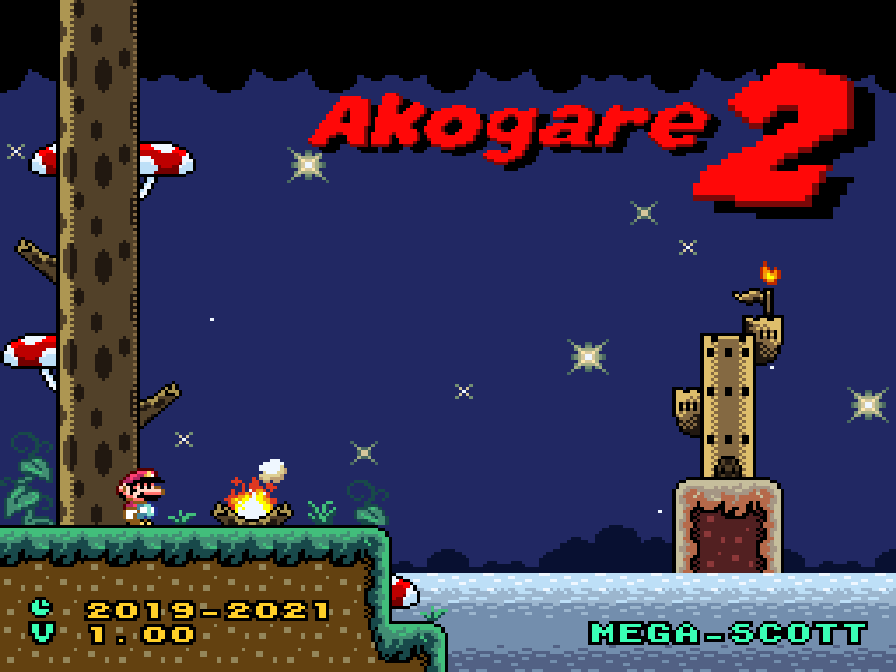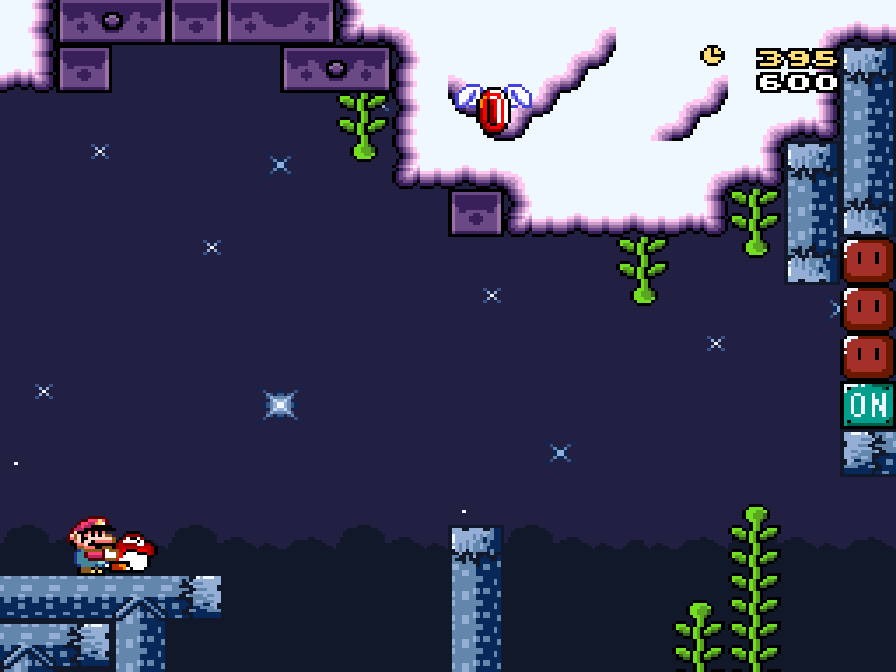Akogare 2 and the Invisible Hand

Playing kaizo requires a different skillset than most other games. You need to understand the language of kaizo to even have a chance at making any headway. Luckily, anyone can learn this language through practice and grinding out more and more hacks as your hands learn the subtleties of Super Mario World that the base game doesn’t make use of. By far the hardest part of learning the language, though, is the invisible movements that aren’t necessarily apparent when you’re looking at the screen. Akogare 2 thrives in these movements and pours all of its energy into showing the player how the more technical subtleties can come together to create amazing-feeling level design to navigate that flows incredibly well. It also shows what happens when you go all in on highlighting the invisible thrills of kaizo, limiting the potential for outwardly memorable level design and risking utilization of button inputs that are too esoteric to be intuitive.
Akogare Mario World garnered a reputation for being an ideal third kaizo hack, bridging the gap between beginner and intermediate hacks by offering a slate of levels that focused on more subtle regrabbing mechanics. If you hold the jump button as you’re falling, you’ll fall slightly slower, letting you perform what’s known as regrabs by letting go of the jump button and pressing it again right away to stay in the air a bit longer without gaining height. This opens up a lot of possibilities that the normal hop-and-bop you can observe doesn’t necessarily communicate.
The problem with Akogare, though, is in its difficulty curve. The first half of the game, though by no means easy, makes pedestrian use of the subtleties, laying bare the bland nature of the levels themselves. Akogare is at its best when it complicates things, requiring a more sophisticated ballet of finger movements from the player that feels incredible when you can nail a level. In this way, Akogare became the budding technician’s kaizo of choice even as much of the experience remained achingly beige.
Looking at Akogare 2 in comparison, creator Mega_Scott immediately remedies the problems with Akogare by being complicated from the word go. The levels are all built in a way that demands input prowess that few hacks focus so hard on. The result is levels that, once correctly executed, flow incredibly well, lending the game its texture and giving the inherent beige tones in the essence of Akogare hints of vibrant color when you’re in the thick of it. Very few games feel as rewarding to nail as Akogare 2.
Once you beat the game and look back on the experience, though, very few levels stand out on their own. By focusing so much on the invisible subtleties of the entire experience, the observable elements of the levels don’t impress on their own. Looking at the scant few levels that do leave an impression, you can easily see why the rest don’t stack up. Obsidian Vale borrows some cool layer-shifting mechanics from Crystal Cove in Bunbun World 2, and the special world features a flying Yoshi level that’s a difficult masterwork. Most notable is Impact Crater, though. While levels that shoot you out of a pipe at extreme speed are a dime a dozen, Impact Crater reminds you that the reason for that is that they’re a lot of fun when expertly crafted.

These three are standouts because you can easily convey what’s cool about them in either description or viewing. Every other level is crafted in a way that makes the entire game flow extremely well and feel amazing to play, but that comes at the expense of making the levels interesting in any way that you can see. Focusing so much on the invisible underpinnings of movement here results in levels that all flow together for better and worse. Not that levels need an obvious gimmick to stand out. You can absolutely create meat-and-potatoes grade kaizo platforming levels memorable. But Akogare 2 fails to do so in service of making the entire experience feel good to pull off. It’s arguable that the cost is worth it.
What’s less arguable is the difficulty with which the game communicates what you’re supposed to do even if you’re experienced with kaizo already. Because so much of what makes Akogare 2 tick is invisible to the observer and heavily input dependent, puzzling out the solution to a section can be difficult even if you look up videos to see how something is accomplished. One glaring example is the late-game Tower of Fate, a vertical level with a puzzling beginning. You’re shot out of a pipe and expected to climb a tower. But the indicator coins, when jumped at normally, lead only to a spiky death. And relying on cannon speed only launches you into spikes before you even hit the ground. What you actually need to do is move as soon as you hit the platform, reach a fast enough speed by running, then jumping and changing direction mid-jump to preserve your speed to launch yourself and keep speed as you glide and jump up the rest of the tower. It would be a standout level, as when executed correctly has the kind of amazing flow that you’d only get in a cape hack like Let’s Give Up. But because it’s so counterintuitive and heavily relies on the invisible, the enthusiasm for the level is tempered significantly. And this isn’t the only time this is a problem in the hack.
Make no mistake: Akogare 2 is an amazing hack and feels incredible to play as a whole. But it’s a flat experience that emphasizes flow and technical prowess at every turn with levels that feel incredibly samey. And it’s a little disappointing after coming off the heels of something like Super Hark Bros. 2, which was fairly uneven, but oozed personality in every facet. After all, it’s difficult to show off when you’re working purely in the invisible.